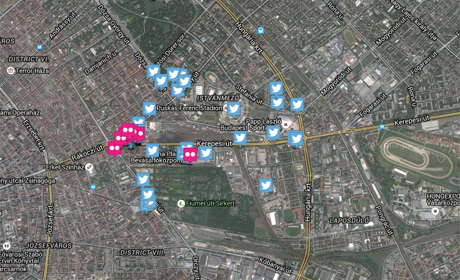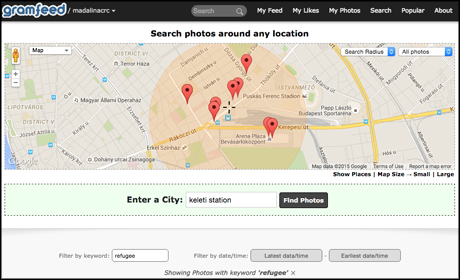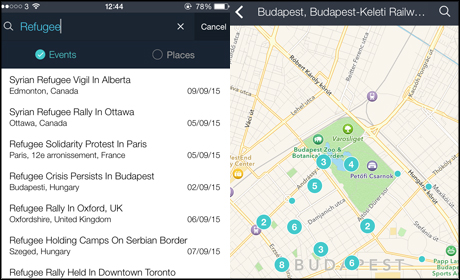
Eyewitness media has become a valuable resource in journalism and news organisations are increasingly using it as a basis for producing multimedia coverage and telling stories in more powerful ways.
However, with an average of 500,000 million tweets posted per day and 40 million photos uploaded daily to Instagram, finding relevant information quickly and accurately can be a challenging and lengthy process.
Geolocation can be very valuable in the newsgathering process, especially in the event of an ongoing breaking news situation, such as the current refugee crisis developing in Europe.
Here are three location-based free tools for finding eyewitness media footage on social media.
EchoSEC
Launched in 2014, echoSEC is a web platform that allows you to discover and monitor posts from specific areas in a given timeframe.
The tool displays an earth view of Google Maps and a search filter. Results can be refined by location – we used Keleti station in Budapest as an example – and time frame, by 'drawing' a circle or rectangle shape around your chosen area.

Screenshot of Echosec, showing results from Keleti station in Budapest, Hungary
The search will populate the map with posts from platforms like Flickr and Twitter, also shown in a more detailed view on the page.
EchoSEC also has a paid version, which gives access to other social media platforms, live data and content feeds for $89 (£57)a month.
Gramfeed
Gramfeed is a similar free platform, but it focuses exclusively on searching images and videos posted on Instagram.
Used by news organisations like reported.ly, Gramfeed also displays a Google Map after you log in with your Instagram account.

Screenshot of Gramfeed
You can then search for a particular location – results can be filtered by date, time or user and it's possible to further narrow down the images by adding a keyword, such as "refugee".
Banjo
Banjo is a free app available on Android and iOS that allows you to connect a number of social media accounts and search across platforms like Twitter, Instagram and Facebook and keep updated on what's happening on the go.
In its home feed, Banjo will display a pre-set feed of categories you can choose from, such as trending events and news, if you're looking for an overview of what people are posting about around the world.
If you already have a location or event in mind, you can use the app's search feature to look for specific events or places that will be shown on a map.

Screenshot of Ban.jo, with the event search feature (left) and map showing results (right)
Posts can be shared or saved, as well as translated, which could be helpful in identifying keywords or hashtags people are using to share footage.
Clicking on a user's profile will give you a smaller map with the exact location the post was shared from.
However, journalists should bear in mind that people's permission needs to be asked before taking and using their footage in stories.
The Eyewitness Media Hub put together a helpful set of guidelines for news organisations handling user generated content, which includes being transparent about how the material will be used and ensuring people are fairly credited.
Sam Dubberley, co-founder of the Eyewitness Media Hub, will be speaking at news:rewired in focus on October 21. The half-day event will focus on the issues surrounding social media search and verification, and the practical skills journalists now need for the job. Find out more here.
Update: The article has been updated to reflect that 500 million tweets are posted on the platform daily, rather than per second.
Free daily newsletter
If you like our news and feature articles, you can sign up to receive our free daily (Mon-Fri) email newsletter (mobile friendly).
Related articles
- 15 online communities for journalists you should know about
- Investigating human trafficking, with ICIJ lead reporter Katie McQue
- The Washington Post's pandemic-born visual forensic team is here to stay (and still works remotely)
- Nadine Ajaka of The Washington Post on the visual forensics team
- Tip: Verifying information during war









